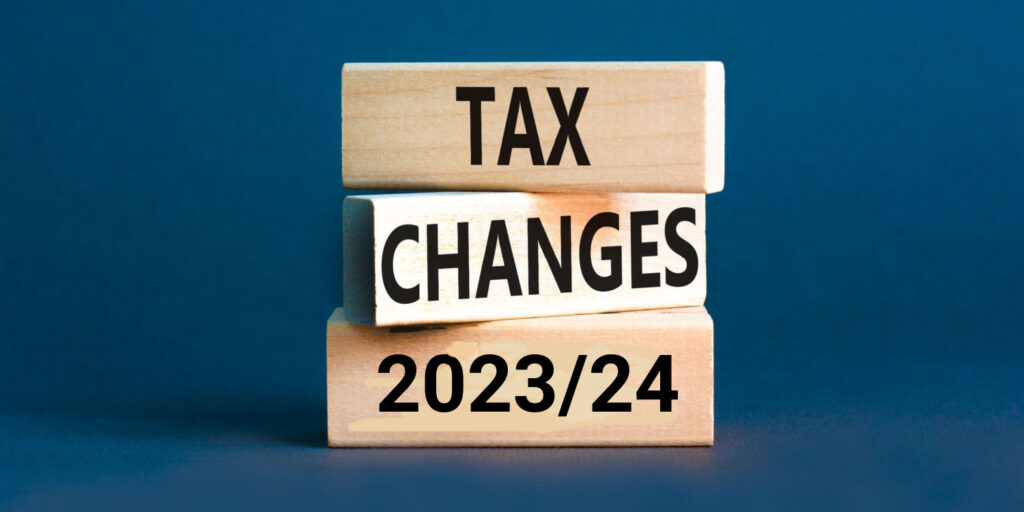The new tax year has arrived, bringing with it a number of changes affecting top earners, company directors and shareholders, and the self-employed.
Differing from the normal calendar year, the UK tax year starts on 6 April and ends on 5 April. It is sometimes referred to as the financial year or accounting year.
We summarise all of the key changes below, which should make it easier for you to work out the potential impact on your business profit and personal income for 2023/24.
1. Income Tax – additional rate threshold lowered
In England, Wales, and Northern Ireland, the following changes to Income Tax came into effect on 6 April 2023:
- The annual earnings threshold for the 45% additional rate was lowered from £150,000 to £125,140
- The annual earnings threshold for the 40% higher rate is now capped at £125,140
The lowering of the threshold means that taxpayers will start paying 45% Income Tax on earnings above £125,140, rather than on earnings above £150,000. This includes company directors, sole traders, and members of business partnerships.
According to GOV.UK, this measure will impact approximately 792,000 UK taxpayers, of whom around 232,000 will now pay the additional rate of Income Tax when they would not have done had the earnings threshold been maintained at £150,000.
The annual Personal Allowance (PA) remains at £12,570 for the new tax year. This is the amount of income that individuals can earn before they have to pay tax.
However, your PA reduces by £1 for every £2 of adjusted net income above £100,000. This means that your allowance will be zero if you earn £125,140 or more in 2023/24.
2. Scottish Income Tax – higher rates for top earners
In Scotland, certain Income Tax rates and thresholds are different from those in England, Wales, and Northern Ireland.
Whilst most of the rates and thresholds remain unchanged, the higher rate of tax has increased from 41% to 42%, and the top rate from 46% to 47%.
In line with the UK additional-rate tax band, the threshold for the top rate of Scottish Income Tax has been reduced from £150,000 to £125,140.
The annual tax-free Personal Allowance (£12,570) and other Scottish Income Tax rates (starter, basic, and intermediate) remain the same as the previous year.
3. Dividend allowance – cut in half
Between 6 April 2018 and 5 April 2023, the dividend allowance for company shareholders was £2,000. It has now been cut in half to just £1,000. This allowance will be further reduced to £500 in 2024/25.
The dividend allowance is the amount of dividend income that a shareholder can receive tax free in a year. Therefore, if you receive dividends from shares in a UK company in 2023/24, you will now pay tax on dividend income above £1,000.
- Dividends – do all shareholders get them?
- Dividend tax guide with calculator 2024-25
- How to Pay Myself from a Limited Company
Our calculations below show the difference in dividend tax liability for the previous year and the new tax year.
In 2022/23, you would pay the following tax on dividend income of £5,000:
- Basic-rate taxpayer – £262.50
- Higher-rate taxpayer – £1012.50
- Additional-rate taxpayer – £1180.50
In 2023/24, you will pay the following tax on dividend income of £5,000
- Basic-rate taxpayer – £350.00
- Higher-rate taxpayer – £1350.00
- Additional-rate taxpayer – £1574.00
There are a number of ways to mitigate dividend tax on income from shares. Speak to your accountant or tax advisor, who will be able to assist with this matter in accordance with your individual circumstances.
4. National Insurance – small rise in Class 2 and Class 3 contributions
After a rollercoaster year of controversial changes in 2022, National Insurance rates and thresholds remain unchanged for 2023/24 – other than a 30p per week increase in Class 2 contributions, and a £1.60 per week rise in Class 3 contributions.
The Class 2 increase means that self-employed people – including sole traders and members of business partnerships and LLPs – will now pay £3.45 per week when they earn more than £12,570 in the current tax year.
If you choose to make voluntary Class 3 payments to fill gaps in your contributions record, you will now pay £17.45 per week for all tax years other than the previous two (2022/2023 and 2021/2022). You will pay the original weekly rates for those two years – £15.85 for 2022/23, and £15.40 for 2021/22.
5. Corporation Tax – no more flat rate
The changes to Corporation Tax, which the government announced in March 2021, came into effect as planned on 1 April 2023.
Replacing the 19% flat rate of Corporation Tax for all companies, the rates for the new tax year are as follows:
- 25% main rate – applies to companies with taxable profits above £250,000
- 19% small profits rate – applies to companies with profits below £50,000
- Marginal Relief rates – companies with profits between £50,000 and £250,000 will pay Corporation tax at a reduced main rate, which gradually increases their effective Corporation Tax rate
Compared to the 19% flat rate, which had been in place since 2017, the new tax rate system will be more costly and complex for companies with annual profits in excess of £50,000.
Speak to your accountant or tax advisor for guidance on reliefs, allowances, and effective tax-saving strategies to reduce your Corporation Tax bill.
6. Capital Gains Tax – allowance reduced
Capital Gains Tax (CGT) applies to the profit you make from selling an asset (e.g. a valuable possession or a second property) that has increased in value. You are taxed on the gain you make, not the total amount of money you receive.
See also: A guide to Capital Gains Tax when selling business assets
For the 2023/24 tax year, the annual tax-free allowance (Annual Exempt Amount) for Capital Gains Tax has been drastically reduced as follows:
- from £12,300 to £6,000 for individuals, personal representatives, and trustees for disabled people
- from £6,150 to £3,000 for other trustees
The Annual Exempt Amount will be further reduced from April 2024, at which point it will be permanently fixed at £3,000 for individuals and personal representatives, and £1,500 for most trustees.
7. Pensions – save an additional £20,000 tax free this year
The pension annual allowance has increased from £40,000 to £60,000 for 2023/24. This is the total amount that you can contribute to your private pension(s) in the new tax year, before you have to pay tax.
The pension lifetime allowance for 2023/24 remains unchanged at £1,073,100. This is the total amount of pension benefits that you can build up during your lifetime across all pension schemes, before an additional tax charge applies.
However, the pension lifetime allowance charge on pensions savings in excess of this amount has been removed. Instead, certain lump sum payments that would have been subject to the lifetime allowance charge will now be subject to Income Tax.
If you took your pension before 6 April 2023, the charge rate is:
- 55% if you receive any amount above the lifetime allowance as a lump sum
- 25% if you receive any amount above £1,073,100 as income (e.g. pension payments or cash withdrawals)
From 6 April 2024, the lifetime allowance will be completely abolished. This means that there will be no cap on how many pension benefits you can build up whilst continuing to enjoy tax relief.
Watch MoneySavingExpert.com founder Martin Lewis’s Budget round-up video to find out what these changes mean for you.
The State Pension has increased by 10.1%, meaning those who qualify for a full new State Pension will get £203.85 per week – up from £185.15 in 2022/23.
Those on the older basic State Pension, who reached the State Pension age prior to April 2016, will now receive £156.20 per week – up from £141.85.
Remember…
Your State Pension entitlement is based on the number of qualifying years of National Insurance contributions you have paid or been credited with, and the year you start claiming it.
You can check your National Insurance record and State Pension forecast on GOV.UK
Thanks for reading
That’s our summary of the new tax year changes for 2023/24, which we hope you have found useful. If you have any questions about this post, please leave a comment below.
Please note that the information provided in this article is for general informational purposes only and does not constitute legal, tax, or professional advice. While our aim is that the content is accurate and up to date, it should not be relied upon as a substitute for tailored advice from qualified professionals. We strongly recommend that you seek independent legal and tax advice specific to your circumstances before acting on any information contained in this article. We accept no responsibility or liability for any loss or damage that may result from your reliance on the information provided in this article. Use of the information contained in this article is entirely at your own risk.












Join The Discussion
Comments (4)
I now have much better clarity on the changes in tax rates ! Thank you :)
We’re glad we were able to clear things up for you.
Kind regards,
The 1st Formations Team
Nice to see the pensions going up! :)
Thanks for your input, Scarlett.
Kind regards,
The 1st Formations Team